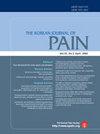Antisense oligodeoxynucleotides against dynamin-related protein 1 reduce remifentanil-induced hyperalgesia by modulating spinal N-methyl-D-aspartate receptor expression in rats
IF 3.4
3区 医学
Q2 CLINICAL NEUROLOGY
引用次数: 1
Abstract
Background Spinal N-methyl-D-aspartate (NMDA) receptor activation is attributed to remifentanil-induced hyperalgesia (RIH). However, the specific mechanism and subsequent treatment is still unknown. Previous studies have shown that the dynamin-related protein 1 (DRP1)-mitochondria-reactive oxygen species (ROS) pathway plays an important role in neuropathic pain. This study examined whether antisense oligodeoxynucleotides against DRP1 (AS-DRP1) could reverse RIH. Methods The authors first measured changes in paw withdrawal mechanical threshold (PWMT) and paw withdrawal thermal latency (PWTL) at 24 hours before remifentanil infusion and 4, 8, 24, and 48 hours after infusion. The expression levels of DRP1 and NR2B were measured after behavioral testing using Western blotting. In addition, DRP1 expression was knocked down by intrathecal administration of AS-DRP1 to investigate the effects of DRP1 on RIH. The behavioral testing, the expression levels of spinal DRP1 and NR2B, and dorsal mitochondrial superoxide were measured. Changes in mitochondrial morphology were assessed using electron microscopy. Results After remifentanil exposure, upregulation of spinal DRP1 and NR2B was observed along with a reduction in PWMT and PWTL. In addition, AS-DRP1 improved RIH-induced PWTL and PWMT (P < 0.001 and P < 0.001) and reduced remifentanil-mediated enhancement of spinal DRP1 and NR2B expression (P = 0.020 and P = 0.022). More importantly, AS-DRP1 reversed RIH-induced mitochondrial fission (P = 0.020) and mitochondrial superoxide upregulation (P = 0.031). Conclusions These results indicate that AS-DRP1 could modulate NMDA receptor expression to prevent RIH through the DRP1-mitochondria-ROS pathway.抗动力蛋白1的反义寡脱氧核苷酸通过调节大鼠脊髓n-甲基- d -天冬氨酸受体表达减少瑞芬太尼诱导的痛觉过敏
背景脊髓N-甲基-D-天冬氨酸(NMDA)受体的激活可归因于瑞芬太尼诱导的痛觉过敏(RIH)。然而,具体的机制和随后的治疗方法仍然未知。先前的研究表明,动力蛋白相关蛋白1(DRP1)-线粒体活性氧(ROS)途径在神经性疼痛中起着重要作用。本研究检测了针对DRP1的反义寡核苷酸(AS-DRP1)是否可以逆转RIH。方法作者首先测量瑞芬太尼输注前24小时和输注后4、8、24和48小时的缩爪机械阈值(PWMT)和缩爪热潜伏期(PWTL)的变化。DRP1和NR2B的表达水平在使用蛋白质印迹的行为测试后进行测量。此外,通过鞘内给予AS-DRP1来降低DRP1的表达,以研究DRP1对RIH的影响。测量行为测试、脊髓DRP1和NR2B的表达水平以及背侧线粒体超氧化物。使用电子显微镜评估线粒体形态的变化。结果瑞芬太尼暴露后,脊髓DRP1和NR2B上调,PWMT和PWTL降低。此外,AS-DRP1改善了RIH诱导的PWTL和PWMT(P<0.001和P<0.001),并减少了瑞芬太尼介导的脊髓DRP1和NR2B表达的增强(P=0.020和P=0.022)。更重要的是,AS-DRP1逆转RIH诱导的线粒体分裂(P=0.020)和线粒体超氧化物上调(P=0.031)。
本文章由计算机程序翻译,如有差异,请以英文原文为准。
求助全文
约1分钟内获得全文
求助全文
来源期刊

Korean Journal of Pain
Medicine-Anesthesiology and Pain Medicine
CiteScore
5.40
自引率
7.10%
发文量
57
审稿时长
16 weeks
期刊介绍:
Korean Journal of Pain (Korean J Pain, KJP) is the official journal of the Korean Pain Society, founded in 1986. It has been published since 1988. It publishes peer reviewed original articles related to all aspects of pain, including clinical and basic research, patient care, education, and health policy. It has been published quarterly in English since 2009 (on the first day of January, April, July, and October). In addition, it has also become the official journal of the International Spinal Pain Society since 2016. The mission of the Journal is to improve the care of patients in pain by providing a forum for clinical researchers, basic scientists, clinicians, and other health professionals. The circulation number per issue is 50.
 求助内容:
求助内容: 应助结果提醒方式:
应助结果提醒方式:


